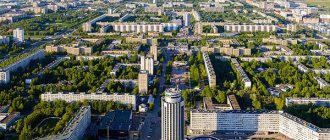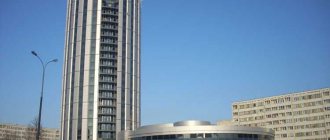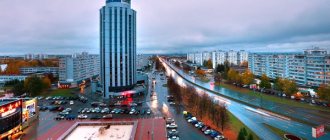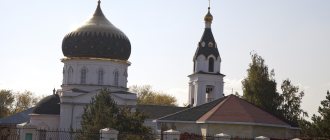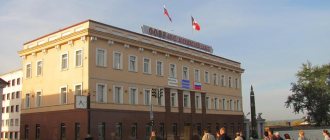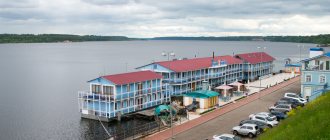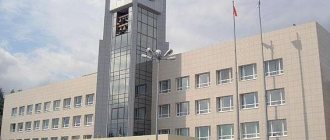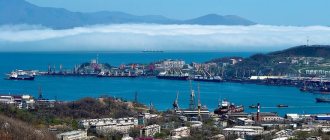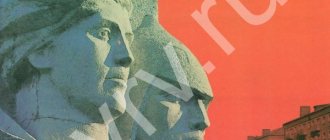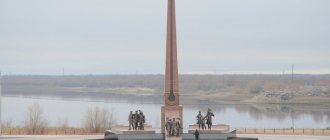Naberezhnye Chelny, which grew up on the site of a small village founded by peasants from Yelabuga, is the only competitor to Tolyatti for the right to be called Russian Detroit. Until the last third of the last century, it was an unremarkable polis, which received city status in 1930. Everything changed in the early 70s, when it was decided to build the Kama Automobile Plant here. In just the next twenty years, the population of Naberezhnye Chelny grew almost 15 times, reaching 500 thousand people. Reliable and practical KAMAZ trucks, rolling off the assembly line of the city-forming enterprise with chronometric punctuality, brought worldwide fame to the policy. Today's Naberezhnye Chelny is not only the most important industrial cluster of the Volga region, but also a significant cultural, educational and tourist center. Any traveler will be interested in visiting here.
Where is the city
The beautiful and clean city of Naberezhnye Chelny is located on the left bank of the Kama , the main tributary of the great Russian river Volga, in the Republic of Tatarstan.
The city of Naberezhnye Chelny is located:
- 205,000 m from the capital of Tatarstan, Kazan;
- 38,000 m from Nizhnekamsk (Republic of Tatarstan);
- 133,000 m from the city of Izhevsk (Republic of Udmurtia);
- 252,000 m from the city of Ufa (Republic of Bashkortostan);
- 299,000 m from Ulyanovsk;
- 319,000 m from Samara;
- 343,000 m from Perm;
- 520,000 m from Yekaterinburg;
- 525,000 m from Nizhny Novgorod;
- 923,000 m from Moscow.
The total area of Naberezhnye Chelny is 171,000 square meters. m. In terms of population, the city ranks 2nd after Kazan. According to 2021 statistics, approximately 534,000 people live here.
City `s history
Naberezhnye Chelny (the sights of the city are clear proof of this) has its own centuries-old history. According to archaeological excavations, the first settlers appeared on the lands occupied by the modern metropolis back in the 3rd century BC. e.
In 1626, a village called Mysovye Chelny was founded here. Later it was renamed Krasnye Chelny. Next door there was another settlement - Berezhnye Chelny. From all these villages a city grew. This status was assigned to the settlement in 1930.
Until 1781, the territory of the settlement was part of the Kazan province, and from 1796 - the Orenburg province. Later, until 1920, the territory became part of the Ufa province. By the end of the 19th century. The city of Naberezhnye Chelny is already the largest timber processing center in the Kama region. This left an imprint on the subsequent growth and development of the city.
At the beginning of the last century, Naberezhnye Chelny was a very developed and rich settlement. In addition to the grain industry, trade and shipping developed well here. A large pier appeared on the Kama.
Educational institutions, churches, retail outlets, flour mills, forestry and other cooperatives are opening in the city. By 1930, when the settlement of Naberezhnye Chelny received city status, about 9,300 people lived here.
The city began to grow and develop rapidly. The main impetus for this was the construction and opening of the Kama Automobile Plant.
For the workers of a new large enterprise of national importance, a lot of housing was built and new neighborhoods were erected. In addition, specialists from all over the USSR traveled to the all-Union construction site. They also needed housing. The population was growing.
In addition to KAMAZ, dairy and meat plants, crane and pipe factories, paper and cardboard factories, construction and other large enterprises appeared in the city. The city opened: a large river port, a railway station, educational institutions, stadiums, palaces of culture, theaters, museums, parks, and exhibition galleries.
The main stage of development of the city of Naberezhnye Chelny occurred during the leadership of the USSR by L. I. Brezhev. In 1982 the city was renamed in his honor. The historical name was returned in 1988. In the 90s. in Naberezhnye Chelny, as in many cities of the country, there was a decline in production and industry in general.
Only in the 2000s. a new rise and development of the city began. A new large automobile plant appears here. The airport has been given the status of “international”. New educational institutions, temples and mosques, parks, stadiums, business and shopping centers opened in the city.
Klyachkinsky Hospital (Ostrovsky St., 11/6)
Hospital.
Source: pastvu.com Directly opposite the Youth Theater is Tukay’s last refuge. This is the clinic of Grigory (Girsh) Klyachkin. Tukay was brought here on February 26 (March 11), 1913. Klyachkin took him, despite the ban on accepting contagious patients, and besides, he treated him for free (payment for monthly treatment cost 150 rubles), since he had the right to accept indigent patients free of charge. One lung was severely damaged and the other was almost unpreserved, tuberculosis, exhaustion, pulmonary and heart failure - this was the doctor’s verdict. Klyachkin talked with Tukai, even sent a lawyer to sort out copyright issues—book publishers were beginning to build a pantheon of fame around the dying poet.
In 1968, at the request of the Chairman of the Union of Writers of the TASSR Garif Akhunov, a memorial museum was created in the Tukai Chamber.
Klyachkin fought in the First World War, worked at the Kazan military hospital, later became the head of the physical therapy department of the Kazan Clinical Institute, headed the department of physical therapy, organizing a phthisiology clinic... He died in 1946.
The main symbols of the city
Naberezhnye Chelny is a city where many sights are its symbols.
"KAMAZ"
“KAMAZ” can be confidently called one of the main symbols of Naberezhnye Chelny. This abbreviation stands for both the famous plant itself, from which the rapid development of the city began, and a car known throughout the world.
In addition, the city has the famous KAMAZ-master racing team - the pride of Naberezhnye Chelny and the whole country, a multiple winner of international rallies and off-road racing.
Location: Naberezhnye Chelny, industrial zone of the city, behind highway No. 1.
Business-
The business, which local residents called “Tyubeteika,” is another recognizable symbol of the city of Naberezhnye Chelny. The 25-story skyscraper appeared 35 years after the start of construction.
Today here is the center of business and cultural life, where shopping, medical and entertainment centers, a cinema, a bank, business offices, cafes and restaurants are located. The top of the building is crowned with an observation deck, from where the city and the Kama River are clearly visible.
Location: Naberezhnye Chelny, Khasan Tufan Avenue, 12.
Letters "YAR Chally"
The letters “YAR Chally”, 8 m high, adorn the hills above the main embankment of Naberezhnye Chelny and are its unique symbol. At a height of 35 meters, the city flag always flutters above the letters.
Location: Naberezhnye Chelny, st. Tabeev embankment.
Central Street
Central Street in Naberezhnye Chelny was once called Dvoryanskaya. It has historical significance. For 100 years, the street was the main one in the village, which was located on the site of the modern city. It contains buildings that are architectural monuments of Naberezhnye Chelny.
The street has a pedestrian zone and decoration in the form of a unique triumphal arch, on which its name is written in 2 languages.
Location: Naberezhnye Chelny, from Avenue named after. Musa Jalil to the Taube Mosque.
"Maidan"
"Maidan" is one of the main squares of the city, which can accommodate up to 15,000 spectators. It is located in the Coastal Park. There is an amphitheater, a large modern screen and stands. All the main festivals of the city take place on the square.
Location: Naberezhnye Chelny, Pribrezhny Park.
Famous places of the city
Naberezhnye Chelny (the city's attractions are among the famous places worth visiting) has buildings of historical significance, and many were created by modern sculptors and architects.
Museum of History and Local Lore
The local history museum has been operating since 1972. Its exhibitions include more than 40,000 types of exhibits. There are authentic artifacts here that tell about the national foundations and traditions of the Tatar people, about the history and chronology of ancient events. Entire exhibitions are housed here, recreating interiors from different eras, events of the war years and archaeological finds.
Location: Naberezhnye Chelny, village. Hydroelectric power station, st. Gidrostroiteley, 16.
Tatar Drama Theater
The State Tatar Drama Theater named after Ayaz Gilyazov was opened in 1990. At that time it did not have its own premises and worked on the territory of the House of Culture. Since 1996 it has its own stage and modern status.
Today the theater troupe includes honored and people's artists of the Republic of Tatarstan. The repertoire is quite varied. It features performances that have won awards from various festivals.
Location: Naberezhnye Chelny, st. Nizametdinova, 29.
Church of Cosmas and Damian
The Church of Saints Cosmas and Damian was in Chelny embankment back in the 18th century, but being wooden it burned to the ground in a fire. The stone church was built in 1859. The temple was very beautiful and immediately became a landmark of the area. In Soviet times, like other churches, it was closed and used as storage facilities.
At the end of the 20th century. the church was returned to the diocese. It was restored, and stone walls and majestic arched gates were erected around it.
Location: Naberezhnye Chelny, Naberezhnye Chelny Avenue, 37A.
Temple of Seraphim of Sarov
The Church of St. Seraphim of Sarov was erected on the banks of the Kama River in 2006. It took about 10 years to build. At the site of its construction, there used to be a church of Elijah the Prophet, which was first closed during Soviet times and then completely demolished. During the construction of the temple, a small chapel was built nearby, where services were held all the years before the opening of the main building.
One of the attractions of Naberezhnye Chelny is the Temple of Seraphim of Sarov
The main value of the temple was the icon of St. Seraphim of Sarov and the unique iconostasis made by Palekh icon painters.
Location: Naberezhnye Chelny, Naberezhnye Chelny Avenue, 3.
Holy Ascension Cathedral
Construction of the Holy Ascension Cathedral began in 1872 and was completed over the course of almost 20 years. During the years of Soviet power, the temple was destroyed. And since the late 80s. last century they began to actively repair it. The domes were restored and bells were brought in. The first service after the restoration was held in 1990.
Today on the territory of the cathedral there is a chapel, a small church for the sacrament of baptism, a library, and a Sunday school.
Location: Naberezhnye Chelny, Chulman Avenue, 127.
Tawba Mosque
The Tauba Mosque began construction in 1989. Its doors opened to parishioners in 1992. The building is made in the Art Nouveau style. The facade of the building is decorated with inscriptions with excerpts from the Koran, and the minaret is more than 50 m high.
Location: Naberezhnye Chelny, kl. Central, 6.
Nur Ikhlas Mosque
The Nur-Ikhlas Mosque is the largest Muslim temple in Naberezhnye Chelny. It is made in a beautiful architectural style, has a large dome and a main minaret 46 m high. The building can accommodate up to 500 people. Near the mosque there is the Coastal Park. The mosque building and grounds are beautifully illuminated in the evening, and there are many flower beds and lawns around.
Location: Naberezhnye Chelny, Chulman Avenue, 108/5.
Victory Park
Victory Park in Naberezhnye Chelny is one of the most popular places among citizens and guests of the city. It was opened in 1975. The park territory is divided into 2 parts. One contains memorable exhibits of military equipment, an alley of heroes of the Great Patriotic War and home front workers. The second part of the park area is reserved for various attractions, playgrounds, and cafeterias.
Location: Naberezhnye Chelny, Mira Avenue, 81.
Boulevard of Enthusiasts
Enthusiastov Boulevard is a pedestrian area in Naberezhnye Chelny. It is all paved with beautiful colored paving slabs. There are many flower beds, sculptural groups and fountains, which are illuminated at night. This beautiful sight leaves no one indifferent.
Local residents and guests of the city love to stroll along the boulevard and relax on the benches along it. It is very beautiful here at any time of the year.
Location: Naberezhnye Chelny, pedestrian zone from Kh. Tufan Avenue to st. Academician Rubanenko.
"Bulgar" (Moskovskaya St., 63)
In 1908, Tukay moved to the famous 40th room of the Bolgar Hotel. It was built by the merchant Ibrahim Appakov. Entrepreneur Fatkulla Akhmadullin turned it into a cheap hotel. Let us remind you that the current building is a new building, built on the site of one demolished in 2008. A hundred years ago, an art cluster was essentially formed here - editorial offices worked, and for some time there was an “Eastern Club” here, where music and theater evenings were held.
As Marcel Akhmetzyanov writes, next to the rooms of “Bulgar” on Moskovskaya, a certain Gabdulla Kildishev was selling kazylyk, who helped Tukai’s mentor in Uralsk, Kamil Motyigi, publish a book of memoirs about the poet. Then next door there was the Sabah library, then there was the tavern of a Tatar named Jamali, and next door there was a hairdresser. The poet also visited them.
The rooms, however, are cold. In 1911, Tukai even wrote a story about this. By this time, the poet was seriously ill, he had tuberculosis. He takes aspirin and doesn't want to go to the doctors.
It’s funny that Appakov’s daughter Bibi-Maryam-Banu lived in the house that now houses the Tukay Museum. There is an opinion that the poet could still visit this mansion, because this family loved crowded meetings. However, there is no direct evidence of this.
Rooms "Bulgar" in the center. Source: pastvu.com
What to see and where to go in Naberezhnye Chelny
Naberezhnye Chelny (the city’s attractions are so numerous that everyone will find entertainment to suit their taste) offers the following places to visit:
| N p/p | Object name | Description | Location |
| 1. | Memorial "Motherland" | Opened on May 9, 1975. Its author is Ildar Khanov, then a young sculptor. The motherland is depicted in the form of a phoenix bird. Her wings are presented in the form of bas-reliefs depicting heroes of the Great Patriotic War. The monument was built very quickly: in just 2 months and a few days. They worked on it without weekends and holidays, almost around the clock. The memorial was opened on the day of the 30th anniversary of Victory in the Great Patriotic War. At its foot the Eternal Flame burns. | Naberezhnye Chelny, at the intersection of Batenchuk Street and Musa Jalil Avenue. |
| 2. | Art Gallery | It first opened its doors to visitors in 1980. It is the main exhibition hall of the city. There is a large fund of works of art of different directions, which is stored on an area of 400 square meters. m. Exhibitions of folk and national art items are very popular. In addition, valuable art exhibits from the most famous museums in the country are brought to the gallery for exhibitions. Over 55,500 people visit the city’s art gallery every year. | Naberezhnye Chelny, Mira Avenue, 52/16. |
| 3. | Museum of Ecology and Nature Conservation | Opened in 2000, it is on the list of the 10 best museums in the country. It contains exhibits on various topics: from paleontology to the animal world of the Republic. In addition, the museum contains exhibits telling about the culture of different peoples and the discoveries of archaeologists. The museum fund has more than 10,000 exhibits and 20,000 different interesting collections. | Naberezhnye Chelny, Friendship of Peoples Avenue, 19. |
| 4. | Monument to Gabdulla Tukay | The monument to the people's poet of Tatarstan is cast in bronze and opened in 2011 in honor of his 125th anniversary. The poet's image is surrounded by figures representing the heroes of his fairy tales, who are loved and recognized by children. | Naberezhnye Chelny, Mira Avenue, Tukay Square. |
| 5. | Monument to V. Vysotsky | An unusual sculpture in memory of the famous songwriter and performer was installed in 2003. It is located opposite the hotel where V. Vysotsky stayed in 1974 during a tour of the Moscow Taganka Theater in the city. The square near the hotel also received Vysotsky’s name. | Naberezhnye Chelny, st. Hydrostroiteley, V. Vysotsky Square. |
| 6. | Ice Sports | The sports facility opened in 2005 and can accommodate up to 1,500 people. In addition to the ice arena, the building houses a buffet, a conference hall, a health and recreation center, a gym, as well as choreography and acrobatics rooms. | Naberezhnye Chelny, Syuyumbike Avenue, 44. |
| 7. | Memorial named after Musa Jalil | The memorial composition in honor of the people's poet, hero of the Great Patriotic War, shot by the Nazis, was opened in 1985 and dedicated to the 40th anniversary of the Victory. In the Republic of Tatarstan they honor the memory of a hero who was not broken by his enemies. Musa Jalil was posthumously awarded the title of Hero of the Soviet Union. | Naberezhnye Chelny, Old Town, Komsomolsky district, M. Jalil Park. |
| 8. | Museum of History and Military Glory of Automotive Troops | The museum was opened in 1986. Here you can learn about the history of the exhibits presented in the exhibitions. These are real combat vehicles that took part in battles. The museum contains collections of real military uniforms and ammunition, as well as famous military weapons. | Naberezhnye Chelny, st. Nizametdinova, 26. |
Tukay's childhood
The first time Gabdulla Tukai settled in Kazan was not of his own free will. As you know, as a child he constantly moved to different relatives, until one day his grandfather gave him to a coachman - he went with him to the Sennaya Bazaar (now this is the territory between the streets of Moskovskaya - Kamala - Stolbov - Parish Commune), where he began to shout: “I’m giving away the child for upbringing, who will take it? Gabdulla was taken by a man named Muhammetvali. He lived in Novo-Tatarskaya Sloboda with his wife Gaziza; they had no children.
As Tukai writes in his memoirs: “My father either traded at a flea market, or was a tanner - I don’t remember this well. Mother tirelessly sewed skullcaps for the rich. Mother, when she wore her skullcaps to the Sennaya Bazaar or went to the house of the rich for some business, sometimes took me with her. Looking at the beautiful decoration of a rich house, large mirrors from floor to ceiling, clocks ringing like church bells, huge like a chest, I thought that people live here as if in paradise.”
Tukay also went with his adoptive mother to the Tashayak fair (today's Fairgrounds) and looked at the toys on the stalls. In the summer he played between two settlements (now Tinchurin Park). Having lived like this from mid-1891 to early 1892, he returned to the village of Uchile - his parents became ill and were afraid to leave him alone.
The house in Novaya Sloboda at Gafuri, 3, was dismantled in 1966-1967, now there is a five-story building.
Where can you go with children?
Naberezhnye Chelny (the sights of the city will be interesting for adults) is famous for its hospitality. There are places here where young tourists can have fun and spend time with benefits for their health and development.
Puppet Theatre
The State Puppet Theater of Naberezhnye Chelny welcomed its first spectators in 1987. Professional actors who love their work and love young spectators work on its stage.
Every year, new productions appear in the theater’s repertoire and more than 300 performances are shown. Folk and traditional holidays are organized and held here. In addition, the Naberezhnye Chelny Puppet Theater goes on tour to other cities of the country and takes part in various theater festivals.
Location: Naberezhnye Chelny, Shkolny Boulevard, 2.
City Dolphinarium
The Dolphinarium in Naberezhnye Chelny is a branch of the famous Anapa Dolphinarium. It is the only one in the Volga region. It can accommodate up to 350 people. The Dolphinarium pool is filled with real sea water and has a depth of 6 m.
Young and adult guests of the city can watch fascinating shows with dolphins and other sea animals here.
You can take a tour of the entire dolphinarium and chat with its inhabitants. Various festive events, diving classes with experienced trainers, and interesting photo sessions are organized here. The main inhabitants of the dolphinarium are dolphins and fur seals.
Opening hours: 9:00 - 19:00 (Tuesday to Sunday). Price for children's tickets: from 550 rubles. up to 800 rub. (depending on the age of the child; for children under 3 years of age, admission is free). Ticket price for adults is up to 1,300 rubles.
Location: Naberezhnye Chelny, st. Tukay Embankment, 12/1.
Amusement Park "Grenada"
The Grenada Culture and Recreation Park is located in a natural area and is considered one of the best parks in the country with extreme entertainment.
There is:
- extreme trails;
- football field;
- simulators;
- basketball and volleyball courts;
- tennis court;
- skate park;
- bike paths;
- slides;
- trampolines;
- swing.
The park has swimming pools for children and adults. The park area is always well-groomed and clean. There are many places to relax on benches or comfortable chairs. The Grenada Amusement Park is a great place for children and adults to relax.
Location: Naberezhnye Chelny, Moskovsky Avenue, 104A.
Editorial office of the newspaper “Al-Islah” (Tukay St., 63)
The house was demolished in 1991, and in its place is a barrier. This newspaper was dedicated to educational reform - it was called for by students of the madrasah, who, under the influence of the revolution of 1905, demanded that education in their institutions be more secular and the teaching procedure more modern. The movement that arose in the Muhammadiyah madrasah was called “Islahchilar”, and it was led by Tukay’s friend Fatih Amirkhan (officially Bakhtiyarov was the editor). Together they published this weekly newspaper, calling for the replacement of “these fools with open and smart ones.” Almost all the writers of that time published in Al-Islah. At the same time, this work did not bring money to Tukay.
St. Tukaya, 63. Source: pastvu.com
Interesting facts about the city
Naberezhnye Chelny is a beautiful, clean and very hospitable city with its own history.
Syuyumbike Avenue, Naberezhnye Chelny
Here are some interesting facts that were not mentioned above:
- Naberezhnye Chelny is the largest city among all located on the banks of the Kama River.
- The population of the city is multinational, the main part of it is Tatars and Russians.
- Archaeologists have established the time of the first settlements on the site of the city, this is the Bronze Age.
- During archaeological excavations carried out within the city, many bones of ancient animals, including mammoths, were found.
- The Nizhnekamsk reservoir, adjacent to the city, is called the sea by local residents (its width is 20,000 m and its length is 185,000 m).
- Every year in August the city hosts a large flower festival, which is usually timed to coincide with the days of the city and the Republic.
The beautiful city on the Kama - Naberezhnye Chelny always welcomes guests. Its most beautiful places and attractions will not leave anyone indifferent and will remain in the memory of everyone who has been here for a long time.
Tukay's grave
Gabdulla Tukai died on April 2 (15th - new style) in 1913 at 20:15. Shops were closed on April 3-4, the Shakirdas read the Koran and its poems in the madrasah, the press was filled with publications about the poet.
Funeral of Tukay. Source: pastvu.com
The procession with Tukai’s body moved towards Yunusovskaya Square (a photograph was taken at the corner of the Sennaya Bazaar), a funeral prayer was read there, after which people moved through the Novo-Tatarskaya Sloboda to the cemetery - now this passage is closed by Tochmash’s buildings. According to various estimates, from five to ten thousand people took part in Tukai’s funeral.
Radif Kashapov
SocietyHistoryCulture Tatarstan
